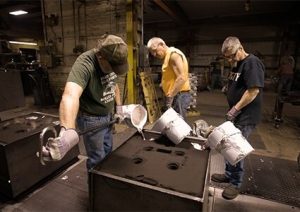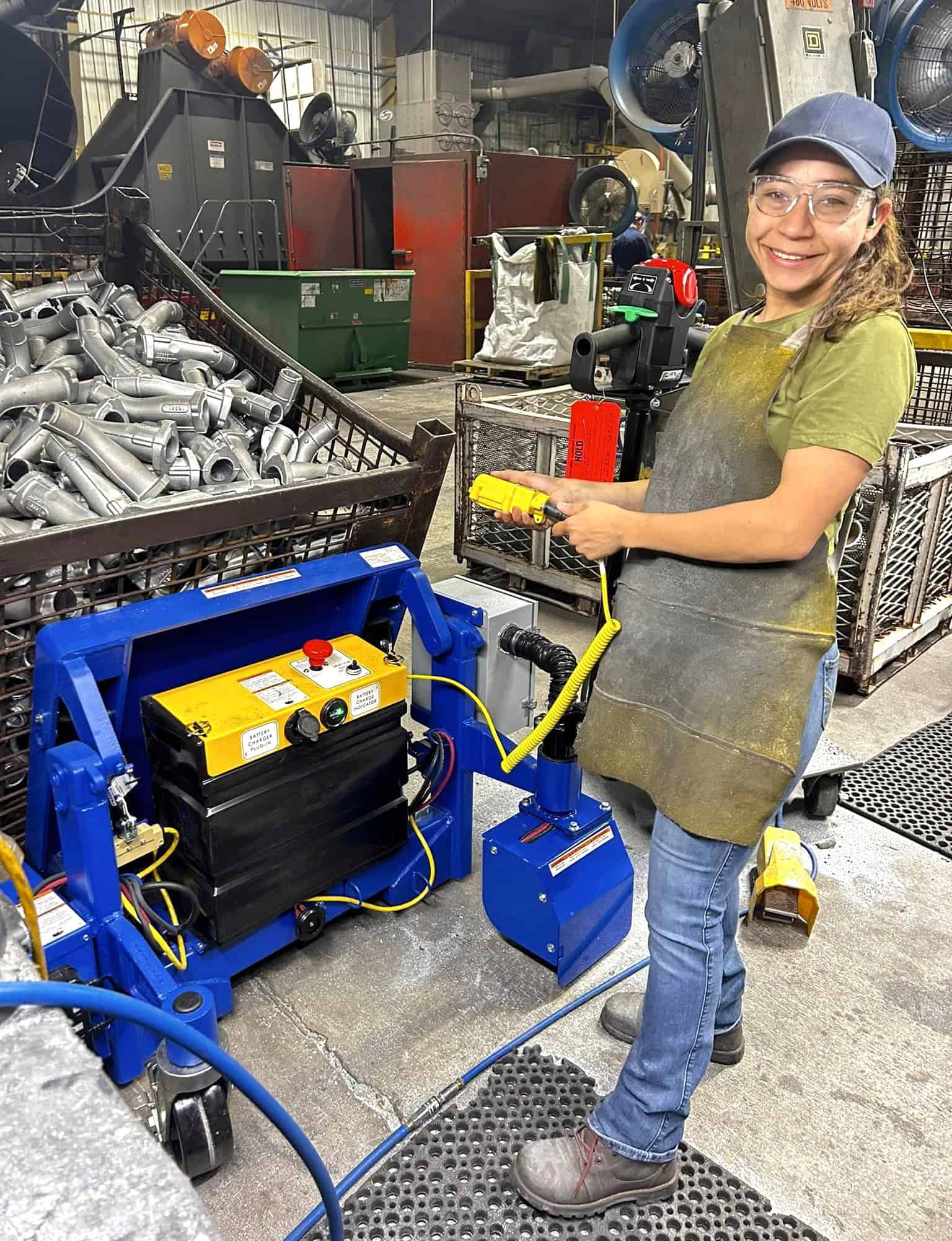From Foundry to Final Product: Aluminum Castings Production Explained
Wiki Article
Checking Out the Cutting-edge Techniques Utilized in Modern Aluminum Foundries
Modern aluminum foundries are undertaking a considerable makeover through the fostering of cutting-edge techniques. Advanced casting techniques, clever automation, and sustainable techniques are reshaping manufacturing procedures. These developments not just boost efficiency however additionally address environmental concerns. As the market advances, the integration of digital modern technologies plays an important function. Recognizing these changes is important for comprehending the future of aluminum manufacturing and its effects for global markets. What exists ahead in this dynamic industry?Advanced Casting Techniques

Furthermore, improvements in thermal control and mold design have actually contributed to more regular casting outcomes. These developments enable better control of cooling down rates, reducing issues and enhancing mechanical properties. Therefore, producers can develop lightweight yet sturdy elements, meeting the raising demands of numerous markets, consisting of vehicle and aerospace, for high-performance aluminum parts.
Smart Automation and Robotics
The combination of wise automation and robotics in aluminum foundries marks a substantial improvement in manufacturing effectiveness. These technologies make it possible for precision and uniformity in production processes, dramatically decreasing human mistake and enhancing security. Automated robotic systems handle recurring tasks, such as molding, putting, and air conditioning, enabling human operators to concentrate on more facility responsibilities that need crucial reasoning and oversight.Additionally, ai-driven analytics and smart sensors give real-time data tracking, promoting predictive maintenance and decreasing downtime. This results in enhanced source allotment and boosted power intake, adding to general sustainability in manufacturing.
In addition, the adaptability of robotic systems permits for fast adjustments to altering production demands, improving adaptability in production. As foundries significantly adopt these advanced innovations, they not only enhance functional efficiency however additionally place themselves as leaders in technology within the steel casting sector.
Additive Production in Foundries
Changing traditional production methods, additive production is reinventing aluminum foundries by enabling the development of complicated geometries that were previously unattainable. This technique enables the layer-by-layer construction of components, substantially lowering material waste and shortening production times. Because of this, foundries can generate detailed styles that improve performance and functionality, satisfying the expanding needs of numerous markets.Additive production assists in rapid prototyping, permitting designers to evaluate and repeat styles rapidly. This dexterity not just accelerates the development cycle but additionally assists in identifying prospective issues prior to full-blown manufacturing begins. The integration of innovative materials and procedures in additive production further boosts the mechanical properties of aluminum parts, advertising advancement in product style. Aluminum foundries that embrace these techniques position themselves at the center of industry improvements, ensuring competition in an ever-evolving market landscape.
Lasting Practices and Recycling
Sustainable methods in aluminum foundries are progressively concentrated on enhancing recycling procedures and adopting green casting techniques. These advancements intend to reduce waste and energy intake while taking full advantage of the use of recycled materials. As the market advances, the integration of sustainability into manufacturing approaches becomes vital for satisfying ecological requirements and consumer needs.Reusing Process Improvements
As industries increasingly acknowledge the environmental effect of waste, aluminum foundries are taking on cutting-edge recycling procedure renovations to enhance sustainability. These developments focus on minimizing power usage and making best use of material healing. Numerous foundries are executing closed-loop systems that recycle scrap aluminum generated during manufacturing, decreasing waste and lowering the demand for virgin products. Advanced sorting innovations, such as computerized optical sorting, boost the splitting up of different aluminum grades, increasing the performance of the reusing process. Additionally, some foundries are using hydrometallurgical techniques to recover aluminum from complex waste streams. By incorporating these enhancements, aluminum foundries not only contribute to a round economic climate however also lower their carbon impact, lining up with global sustainability objectives.Eco-Friendly Casting Techniques
While standard casting techniques frequently involve substantial energy consumption and product waste, aluminum foundries are progressively adopting environment-friendly casting techniques that focus on sustainability. Techniques such as low-pressure die casting, which reduces air exhausts, and using water-based mold and mildew releases add to decreased environmental influence. In addition, advancements in 3D printing modern technology enable the production of complicated molds with much less material waste. Several foundries are likewise implementing closed-loop systems that reuse water and aluminum scrap, further reducing resource intake. By accepting renewable resource resources, such as solar and wind power, these facilities improve their sustainability efforts. Generally, the fostering of environment-friendly practices in aluminum casting not only profits the environment yet also promotes financial efficiency and advancement within the industry.Enhanced Top Quality Control Measures
Boosted high quality control procedures in aluminum foundries are increasingly reliant on advanced assessment modern technologies and real-time monitoring systems. These advancements make it possible for manufacturers to discover issues early and guarantee consistent product high quality. By incorporating these devices, foundries can considerably enhance their functional performance and lower waste.Advanced Inspection Technologies
Advanced evaluation technologies play a vital function in guaranteeing the quality and dependability of aluminum castings. These published here innovative techniques consist of non-destructive testing (NDT) methods such as ultrasonic testing, radiographic testing, and swirl present inspections. Each method enables comprehensive examination of castings without endangering their architectural stability. Advanced imaging methods, such as computed tomography, supply a considerable sight of interior functions, allowing the detection of defects like incorporations and gaps. Furthermore, automated optical assessment systems improve precision by using high-resolution electronic cameras and artificial intelligence algorithms to analyze surface area high quality. By executing these advanced examination modern technologies, aluminum foundries can efficiently minimize issues, making certain that castings fulfill rigid industry criteria and client requirements.Real-Time Surveillance Solutions
As manufacturers undertaking for excellence in aluminum casting, real-time surveillance systems arise as a crucial enhancement in quality assurance actions. These systems utilize innovative sensors and information analytics to constantly track critical criteria during the casting procedure, such as temperature, stress, and alloy structure. By providing instant comments, they enable operators to recognize discrepancies from excellent problems and make timely adjustments. This aggressive approach not only minimizes issues yet additionally boosts overall efficiency and reduces waste - Aluminum Castings. Additionally, assimilation of real-time data right into manufacturing monitoring systems helps with far better decision-making and boosts traceability. Consequently, real-time surveillance systems play a necessary function in maintaining high requirements of top quality in modern aluminum foundries, making sure that products fulfill rigorous industry requirementsDigital Double Innovation for Optimization

The integration of digital twin innovation enables foundries to examine different circumstances without interrupting real production. This capability promotes an aggressive approach to upkeep and source monitoring, eventually reducing waste and reducing functional expenses. click resources In addition, the modern technology aids in process optimization by permitting engineers to envision the effects of changes in real-time, making sure better end results. Consequently, aluminum foundries adopting digital twin innovation are positioned to accomplish greater efficiency and competitiveness in a progressively demanding market.

Industry 4.0 and IoT Assimilation
The fostering of electronic twin modern technology in aluminum foundries is part of a wider activity in the direction of Sector 4.0, defined by the assimilation of the Net of Things (IoT) into manufacturing processes. This assimilation allows real-time monitoring and data collection from different equipment and tools, bring about boosted operational performance. Sensing units embedded in devices collect vital information, which is assessed to enhance production process and forecast maintenance needs.IoT devices promote communication between different production stages, permitting for seamless sychronisation and decreasing downtime. By leveraging cloud computing, foundries can save and assess huge quantities of data, enabling even more educated decision-making. This modern technology additionally sustains remote monitoring, where drivers can manage procedures from anywhere, boosting responsiveness to manufacturing challenges. In general, the fusion of Market 4.0 and IoT within aluminum foundries is changing traditional methods, making them a lot more nimble and responsive to market needs.
Regularly Asked Questions
What Are the Key Advantages of Aluminum Over Other Steels?
Aluminum supplies various benefits over other metals, including its lightweight nature, outstanding rust resistance, high thermal and electric conductivity, pliability, and recyclability, making it a favored selection for various applications throughout several sectors. - Wisconsin Aluminum FoundryExactly How Do Modern Foundries Manage Hazardous Products?
Modern foundries take care of hazardous products through strict safety and security protocols, progressed purification systems, and reusing approaches. Normal training assurances workers comprehend best methods, while monitoring systems find and mitigate prospective threats to preserve a secure workplace.What Is the Regular Lifespan of Aluminum Castings?
The common life expectancy of aluminum castings varies from 20 to 50 years, relying on variables such as environmental problems, use, and upkeep. Correct treatment can expand their toughness and efficiency considerably gradually.Exist Any Health Threats Linked With Aluminum Foundry Job?
Yes, aluminum factory job postures health and wellness dangers, including respiratory problems from breathing in fumes and dirt, skin irritability from call with liquified steel, and possible exposure to hazardous chemicals. Proper precaution are vital to reduce these threats.Just How Do Foundries Make Sure Employee Safety And Security in High-Temperature Environments?
Factories apply strenuous safety and security protocols, consisting of safety gear, temperature monitoring systems, and normal training. These my company measures ensure that employees are geared up to deal with high-temperature environments, minimizing dangers and advertising a much safer office.
Many innovative casting strategies have actually arised in aluminum foundries, transforming traditional procedures. Lasting methods in aluminum foundries are increasingly focused on boosting reusing processes and adopting environmentally friendly casting strategies. Several foundries are carrying out closed-loop systems that recycle scrap aluminum generated throughout manufacturing, decreasing waste and minimizing the need for virgin products. While typical casting techniques often entail significant power consumption and material waste, aluminum foundries are significantly adopting green casting strategies that prioritize sustainability. While many industries are significantly adopting digital technologies, aluminum foundries are leveraging digital twin technology to improve functional efficiency and enhance production procedures.
Report this wiki page